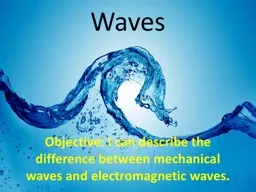

difference between mechanical waves and electromagnetic waves What is a wave A wave is a moving disturbance that transfers energy through matter or space Examples of waves Water waves light waves ID: 810058
Download The PPT/PDF document "Waves Objective: I can describe the" is the property of its rightful owner. Permission is granted to download and print the materials on this web site for personal, non-commercial use only, and to display it on your personal computer provided you do not modify the materials and that you retain all copyright notices contained in the materials. By downloading content from our website, you accept the terms of this agreement.
Slide1
Waves
Objective: I
can describe the
difference between mechanical waves and electromagnetic waves.
Slide2What is a wave?
A wave is a moving disturbance that transfers energy through matter or space.
Slide3Examples of waves
Water waves light waves
Sound waves microwaves
Slide4Radio waves X-ray waves
Ultraviolet waves seismic waves
Slide5All of these waves can be put into 2 categories:
Waves that
do not
require a medium
Waves
that
require
a medium
Slide6So what’s a medium?
A
medium
is something through which a wave travels. (solid, liquid, or gas!)
In a water wave, the medium is the water.
In a sound wave, the medium is the air.
In an earthquake, the medium is the ground.
Does light require a medium?
Slide7Well, where does light come from?
If it can travel through NOTHINGNESS, then it doesn’t need a medium
Slide8Back to our 2 groups
Electromagnetic waves
can transfer energy through a medium
OR
through empty space
(a vacuum)Ex. Radio waves, light waves, infrared waves, ultraviolet waves, x-rays, gamma rays
Mechanical Waves
are waves that require a medium in order to transfer energy.Ex. Sound waves, water waves, seismic waves
Slide9Review
What is a medium?
Do electromagnetic waves require a medium?
Give an example of an electromagnetic wave.
Do mechanical waves require a medium?
Give an example of a mechanical wave.
Slide10Mechanical wave Electromagnetic wave
Slide11Transverse and Longitudinal Waves
Objective: I will be able to differentiate between transverse and longitudinal waves.
Slide122 different ways to create a wave:
Slide13Now lets see these two wave types in action
http://
www.acs.psu.edu
/
drussell
/demos/waves/
wavemotion.html
Slide14Let’s look back at the waves
Now, when you watch the waves, notice how the particles of the medium are moving in different ways.
Note:
Which direction is the wave moving in?
Which direction are the particles moving in?
Are these two directions the same?
http://www.acs.psu.edu/drussell/demos/waves/wavemotion.html
Slide15Longitudinal Waves
In a longitudinal wave, the particles of the medium vibrate
in the same direction
as (or
parallel
to) the direction that the wave is travelling
Slide16Longitudinal waves (where particles move parallel to the direction of the wave) are something you experience every day in the form of SOUND!
Slide17Slide18Transverse Waves
In a transverse wave, the particles of the medium vibrate
in the opposite direction
of (or
perpendicular
to) the direction that the wave is travelling
Slide19Transverse waves (where the particles move perpendicular to the direction of the wave) are also all around you in the form of LIGHT!
Slide20Review
In a ___________ wave the particles of the medium vibrate PERPENDICULAR to the direction the wave is travelling.
In a ___________ wave the particles of the medium vibrate PARALLEL to the direction the wave is travelling.
Sound is an example of a ________ wave.
Light is an example of a ________ wave.
Slide21Transverse Wave Longitudinal Wave
Slide22Wave Parts
Objective: I will be able to identify and label the main parts of a wave
.
Slide23Wavelength
The distance between one point on a wave and the exact same point on the next wave
Slide24Amplitude
The maximum extent of vibration or the distance from the resting position of the medium to the crest or trough
Slide25Frequency
The number of waves produced in a given amount of time
Slide26Crest and trough
The highest/lowest point of a transverse wave
Slide27Compression and rarefaction
The squished up or spread out parts of a longitudinal wave
Slide28Review
Draw a transverse wave and label
Wavelength
Amplitude
Crest
Trough
Slide29Review, continued
2. Draw a longitudinal wave and label
Wavelength
Compression
rarefaction
Slide30Practice 1
Slide31Practice 2